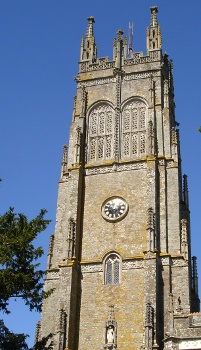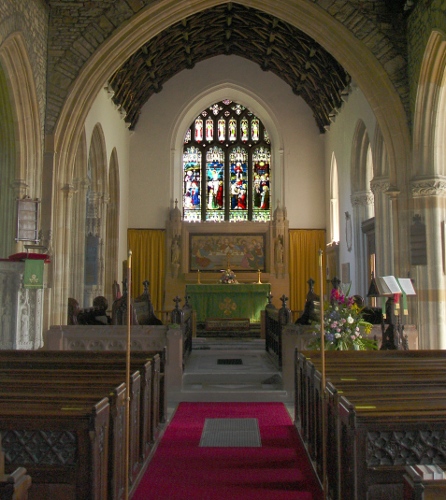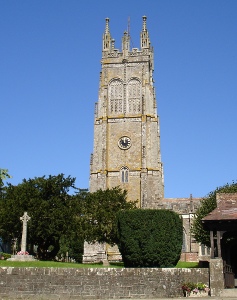Situated in North Devon between Barnstaple and South Molton, Chittlehampton was first settled by the Saxons during their 8th century invasion of Devon. At its heart is The Square, a wide open space sloping upwards towards the church on its northern boundary. The outline of the square has changed little since that time. Up until the late 19th century the village was noted for the large number of hostelries serving a community of this size, a reminder of the days when these inns were needed to accommodate the many pilgrims visiting the shrine of St Urith in the church.

St Hieritha's Church

The church was completely rebuilt between 1470 and 1520 on the site of the earlier cruciform structure. It is dedicated to a revered Celtic saint from the dawn of Christianity in Devon, St Hieritha or more correctly, St Urith. It contained a shrine in her honour that was visited by pilgrims on the 8th of July each year until 1540 by which time pilgrimages and the veneration of saints and relics were drawing the ire of the Protestant Reformation. The generous offerings of the many visitors to the shrine made it possible to rebuild the church on such a grand scale.

The magnificent western tower in the Somerset style now dominates the northern edge of the wide village square, once known as Town Place. In former times the church was partly hidden behind a row of houses as can be seen in the engraving from 1846. These dwellings were demolished between 1876 and 1879 not long after the most recent major refurbishment of the church in 1872.
The cottages bordering the church belonged to the Feoffees, a board of trustees administering the church and its property estate for the benefit of the community, and were sold by auction to the Trustees of the Rolle Estate who permitted the site to be enclosed within the churchyard following the demolition worknote1.

Inside the church, facing towards the chancel one can make out the rectangular reredos in the distance. Added in the 1872 refurbishments, it is a colourful mosaic depicting the Last Supper. Prior to that it was an exhibit at the Great Exhibition of 1851 in Crystal Palace. The font dating from ca. 1500 was placed under the tower in 1872, then moved to its present position near the main door in 1954.
There is a local tradition for comparing the attributes of North Devon churches using sayings that go like this:

Chittlehampton is usually given the beauty accolade, but the churches selected for their length and strength vary parochiallynote4.
The Legend of St Urith
What do we know of St Urith? Very little it would seem, other than that she was born in nearby Stowford possibly in the 7th century AD or even earlier and was a pious Christian who suffered a violent death at a tender age. One suggestion is that she may have been converted to Christianity by one or more of St Kea, St Fili, and St Rumon, missionaries from Glastonbury who passed through this area on route to Cornwall in the early 6th century.note2
The fullest account of her brief life is given in Chanter's 1914 essay[1]. Chanter argues convincingly that her rightful name is Urith, and that Hieritha is a later corruption; he quotes these passages from the renowned 17th century North Devon topographers Risdon and Westcote which demonstrate that Hieritha was the accepted written form of the name by this period.
Risdon refers to a book of her life, but there is no trace of this work today; reputedly it was exhibited in her shrine, and it may be that the book was lost or destroyed when this was dismantled in 1540.
Chanter turns to the hymn to St Uritha (the Latinate form of Urith) discovered in a manuscript in Trinity College Cambridge in 1901 as the prime source for the account of Urith's martyrdom. This was part of a 15th century notebook belonging to a monk from Glastonbury. Here are the three most relevant verses with translations of the original Latinnote5:
|
Gaudet quia falcatorum
Falce prato iniquorum
Martirium sustinuit
Virgo martyr nunc sanctorum
Consorcia angelorum
In premium promeruit
Hostium minas non expauit
Hostes morte superauit
Hostes quos absorbuit
Ubi virgo expirauit
>Fons habunde emanauit
Sicca terra floruit
Nunc gaudet tota patria
Quod sue nouerce odia
Innocens virgo vicerit
villa Chitelhamptonia
Letare cum Deuonia
Quod taliter se gesserit.
|
Mown by scythe of pagan scornful,
Gladly in the valley mournful
Crown of martyrdom she gain'd.
Now, 'mid Angels high and holy,
See, enthroned, this maiden lowly
Hath the victor's prize obtained.
Trembled she at threat of no man,
But did triumph o'er the foeman -
Foeman whom she overthrows.
There, where fell this godly maiden,
Sprang a well with virtue laden,
Bloom'd the desert as the rose.
By stepmother once ill-treated,
Now on every side is greeted,
Urith as the lily, white.
Chittlehampton voice to heaven,
Raise thou with the rest of Devon,
For this martyr, ruby-bright.
|
Chanter summarizes the legend in these words:
St Urith's martyrdom is said to have occurred at St Urith's Well marked on the map to the east of the village. It is also known as St Teara's Well, or Taddy Well. In the 1950s it was capped for safety reasonsnote6
Whether or not there is any truth to this story we may never know, but what is certain is that this legend bears an uncanny similarity to that of two other Devonshire saints of the Saxon period, St Sidwell and her sister St Juthwara, leading Chanter to speculate on the apocryphal nature of these legends, and to suggest that "the story as we have it may only be that of a professional saint life-writer of a later date".
The Inns of Chittlehampton
Today Chittlehampton has but one Inn, The Bell, a very fine one too. In former times it had a surprising number for its size. Historically this was not because the inhabitants had an unquenchable thirst or were particularly debauched; rather they provided a place of refreshment and rest for the many pilgrims who came to the village to pay homage to St Urith.
What is surprising is that so many licensed premises survived to the middle of the 19th century, more than 300 years after the end of the annual pilgrimages to Chittlehampton following the dismantling of St Urith's shrine. White's Directory of 1850[4] lists six inns and taverns:
- the Barnstaple Inn
- the Bell Inn
- the Exeter Inn
- the Golden Lion
- the New Inn
- the Rolle's Arms
White also mentions the existence of two unnamed beer houses one of which was evidently the Green Dragon. The Barley Mow, possibly the other beer house, can be added to this list, and there was also a Kings Arms which had closed by this date.
This piece entitled The Inns of Chittlehampton by The Rev. J H B Andrews, vicar of Chittlehampton at the time, was written for the Parish Magazine in 1954. I have edited it lightly in the interests of clarity:
The number of inns declined as the 19th century was drawing to a close; when the license of the New Inn came up for renewal in 1884 it was declined, leaving only two other licensed premises.note7
The Bell Inn moved to its present location on the south side of The Square in 1888. It has been run by the same family for the past 30 years. On a recent visit in 2010 I noticed they offered a fine selection of real ales from Devonshire breweries. There is a smoker-friendly terrace to the rear leading down through a children's play area to an orchard containing a pair of alpacas who obligingly posed for the camera on this occasion.




